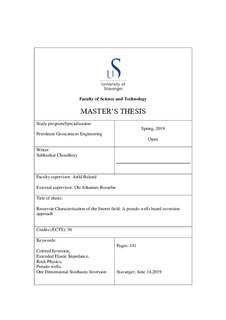| dc.contributor.author | Choudhury, Subhankar | |
| dc.coverage.spatial | Norwegian North Sea | nb_NO |
| dc.date.accessioned | 2019-09-30T11:38:44Z | |
| dc.date.available | 2019-09-30T11:38:44Z | |
| dc.date.issued | 2019-06-14 | |
| dc.identifier.uri | http://hdl.handle.net/11250/2619369 | |
| dc.description | Master's thesis in Petroleum Geosciences Engineering | nb_NO |
| dc.description.abstract | Complex reservoirs make hydrocarbon exploration challenging, and therefore improvement of methods for discovering and producing hydrocarbons is desired. Consequently, various seismic inversion algorithms have been developed to provide better characterization of the reservoir. One Dimensional Stochastic Inversion (ODiSI) is one such method that has been applied in the study which inverts seismic data by matching to large number of pseudo wells.
Inversion studies have been applied to a producing sandstone field, with the objective to improve the reservoir characterization and acquire accurate estimations of facies and reservoir properties together with the associated uncertainities. The study area is the Snorre field in the Norwegian sector of the North Sea. The reservoir has complex geology due to presence of several large fault blocks and is grouped into various zones containing sandstones of the Statfjord and Lunde Formations. The reservoir is highly heterogeneous with varying reservoir quality (i.e. net to gross, porosity).
The inversion study includes building pseudo wells which essentially encompasses an acceptable sampling of the area of interest. Lithofacies columns are populated using geologically realistic bed-thickness distributions. Each pseudowell is built with a full suite of well log curves generated from a rock physics model. The rock physics model/trend depends on porosity depth trends, moduli relationships and velocity trends from calibration well. In addition, seismic data are color inverted to be accepted as input for the inversion process. Synthetics based on Extended Elastic Impedance are used in the matching process. Finally, inversion is carried out resulting estimates of facies probabilities and reservoir properties.
Only one well containing S-sonic functions as the calibration well. Based on rock physics analysis, it is observed that the reservoir and non-reservoir facies is distinguishable in impedance domain. Different combinations of color inverted chi angle stacks such as near-mid and mid-far were used as an input. The blind well predictions were considerably accurate. However, predictions in mid-far combination came out to be more consistent in comparison to that of near-mid.
In addition, the study illustrates the quality of algorithm which generates laterally stable results. | nb_NO |
| dc.language.iso | eng | nb_NO |
| dc.publisher | University of Stavanger, Norway | nb_NO |
| dc.relation.ispartofseries | Masteroppgave/UIS-TN-IER/2019; | |
| dc.rights | Navngivelse 4.0 Internasjonal | * |
| dc.rights.uri | http://creativecommons.org/licenses/by/4.0/deed.no | * |
| dc.subject | petroleumsgeologi | nb_NO |
| dc.subject | colored inversion | nb_NO |
| dc.subject | extended elastic impedance | nb_NO |
| dc.subject | rock physics | nb_NO |
| dc.subject | one dimensional stochastic inversion | nb_NO |
| dc.subject | pseudo-wells | nb_NO |
| dc.title | Reservoir Characterization of the Snorre field: A pseudo wells based inversion approach | nb_NO |
| dc.type | Master thesis | nb_NO |
| dc.subject.nsi | VDP::Technology: 500::Rock and petroleum disciplines: 510::Geological engineering: 513 | nb_NO |
| dc.subject.nsi | VDP::Mathematics and natural science: 400::Geosciences: 450::Petroleum geology and petroleum geophysics: 464 | nb_NO |

